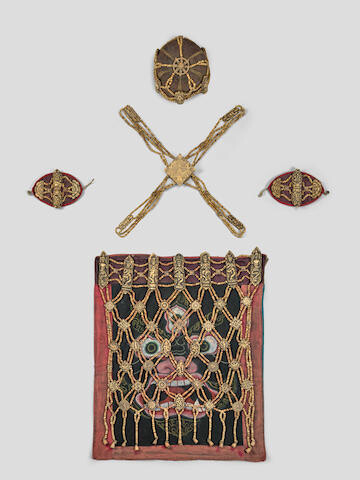A BONE RITUAL ENSEMBLE
NEPAL, 18TH/19TH CENTURY
NEPAL, 18TH/19TH CENTURY
Himalayan Art Resources item no.4490
Girdle: 27 x 22 in. (68.6 x 55.9 cm);
Armlets: 5 1/8 x 6 1/2 in. (13 x 16.5 cm) and 5 x 7 1/8 in. (12.7 x 18.1 cm);
Chest Piece: 21 1/2 in. (54.6 cm) long;
Cap: 3 3/4 in. (9.5 cm) high
尼泊爾 十八/十九世紀 骨雕法衣
This is a rare instance of a Buddhist bone ritual apron preserved with most of its parts. To its crown, chest piece, bracelets, and girdle would have been added armlets and anklets. The girdle is still backed with a textile painted with a Mahakala face. Together with the harmonious, symmetrical pairing of Buddhist symbols linked throughout the girdle's beaded nexus, it indicates an intact and undisturbed composition.
The carving of each ornament is excellent. The girdle's waist belt features a row of five dakinis flanked by chitipati, all dancing. Vajrayogini occupies the very center of the belt, pictured below her spiritual sire Akshobhya Buddha. The descending chain of auspicious symbols includes lotuses, visvavajras, and 'endless knots', and each final strand terminating with a bell (ghanta), a symbol of the divine wisdom Vajrayogini embodies.
The ensemble's bracelets feature cosmic symbolism, showing two halves of a lotus penetrated by a vajra-form pillar embellished with beautiful scrollwork. The chest piece has front and back medallions carved into a dharma wheel and a talismanic kirtimukha face. The crown is carved with five leaves each showing a dried skull supporting a flaming triratna, which are linked to a dharma wheel surmounting the textile cap.
Ritual attire like the present lot could be used to decorate life-size sculptures of deities, although they were more often worn by monks and lamas during public festivals and ceremonies, including masked dances in which the performers meditated on and transformed themselves in Dakinis, Yidams and Dharmapalas (see Ramos, Tantra: Enlightenment to Revolution, 2020, p.168). See a closely related Nepalese bone apron preserved at the USC Pacific Asia Museum, Pasadena (2001.1.45).
Provenance:
Private Belgian Collection, acquired in Nepal, 1970s
View it on
Sale price
Estimate
Time, Location
Auction House
NEPAL, 18TH/19TH CENTURY
NEPAL, 18TH/19TH CENTURY
Himalayan Art Resources item no.4490
Girdle: 27 x 22 in. (68.6 x 55.9 cm);
Armlets: 5 1/8 x 6 1/2 in. (13 x 16.5 cm) and 5 x 7 1/8 in. (12.7 x 18.1 cm);
Chest Piece: 21 1/2 in. (54.6 cm) long;
Cap: 3 3/4 in. (9.5 cm) high
尼泊爾 十八/十九世紀 骨雕法衣
This is a rare instance of a Buddhist bone ritual apron preserved with most of its parts. To its crown, chest piece, bracelets, and girdle would have been added armlets and anklets. The girdle is still backed with a textile painted with a Mahakala face. Together with the harmonious, symmetrical pairing of Buddhist symbols linked throughout the girdle's beaded nexus, it indicates an intact and undisturbed composition.
The carving of each ornament is excellent. The girdle's waist belt features a row of five dakinis flanked by chitipati, all dancing. Vajrayogini occupies the very center of the belt, pictured below her spiritual sire Akshobhya Buddha. The descending chain of auspicious symbols includes lotuses, visvavajras, and 'endless knots', and each final strand terminating with a bell (ghanta), a symbol of the divine wisdom Vajrayogini embodies.
The ensemble's bracelets feature cosmic symbolism, showing two halves of a lotus penetrated by a vajra-form pillar embellished with beautiful scrollwork. The chest piece has front and back medallions carved into a dharma wheel and a talismanic kirtimukha face. The crown is carved with five leaves each showing a dried skull supporting a flaming triratna, which are linked to a dharma wheel surmounting the textile cap.
Ritual attire like the present lot could be used to decorate life-size sculptures of deities, although they were more often worn by monks and lamas during public festivals and ceremonies, including masked dances in which the performers meditated on and transformed themselves in Dakinis, Yidams and Dharmapalas (see Ramos, Tantra: Enlightenment to Revolution, 2020, p.168). See a closely related Nepalese bone apron preserved at the USC Pacific Asia Museum, Pasadena (2001.1.45).
Provenance:
Private Belgian Collection, acquired in Nepal, 1970s



